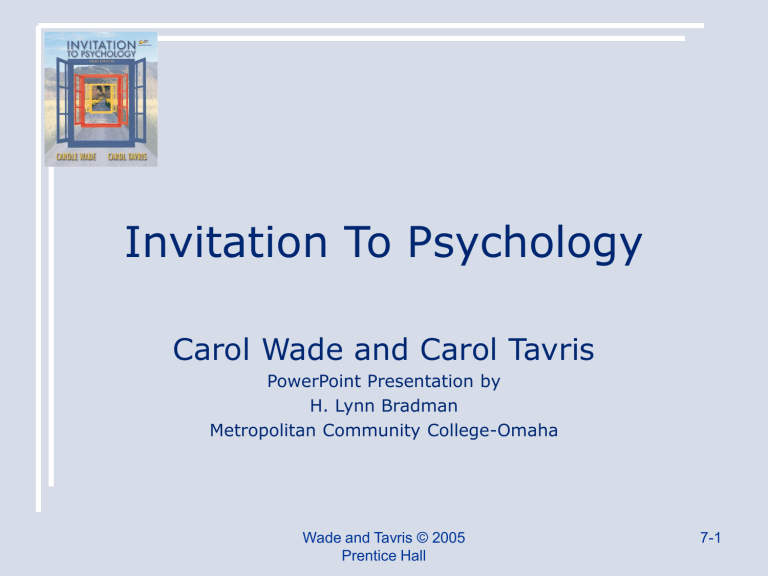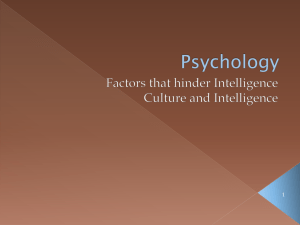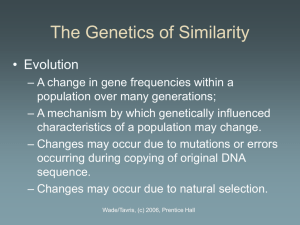View Presentation

Invitation To Psychology
Carol Wade and Carol Tavris
PowerPoint Presentation by
H. Lynn Bradman
Metropolitan Community College-Omaha
Wade and Tavris © 2005
Prentice Hall
7-1
Thinking and Intelligence
Wade and Tavris © 2005
Prentice Hall
7-2
Thinking and Intelligence
• Thought: Using What We Know
• Reasoning Rationally
• Barriers to Reasoning Rationally
• Intelligence
• The Origins of Intelligence
• Animal Minds
Wade and Tavris © 2005
Prentice Hall
7-3
Thought: Using What We Know
The Elements of Cognition
How Conscious Is Thought?
Wade and Tavris © 2005
Prentice Hall
7-4
The Elements of Cognition
• Concept: Mental category that groups objects, relations, activities, abstractions, or qualities having common properties.
• Proposition: A unit of meaning that is made up of concepts and expresses a single idea.
• Mental Image:
Representation that mirrors or resembles the thing it represents.
• Cognitive Schema: An integrated mental network of knowledge, beliefs, and expectations concerning a particular topic or aspect of the world.
Wade and Tavris © 2005 7-5
Prentice Hall
How Conscious is Thought?
• Subconscious Processes: Mental processes occurring outside of conscious awareness but accessible to consciousness when necessary.
• Nonconscious Processes: Mental processes occurring outside of and not available to conscious awareness.
Wade and Tavris © 2005
Prentice Hall
7-6
Reasoning Rationally
Wade and Tavris © 2005
Prentice Hall
7-7
Reasoning Rationally
• Formal Reasoning: Algorithms and Logic
• Informal Reasoning: Heuristics and
Dialectical Thinking
• Reflective Judgment
Wade and Tavris © 2005
Prentice Hall
7-8
Formal Logic
• Deductive Reasoning:
A tool of formal logic in which a conclusion necessarily follows from a set of observations or propositions (premises).
Wade and Tavris © 2005
Prentice Hall
7-9
Formal Logic
• Inductive Reasoning:
A tool of formal logic in which a conclusion probably follows from a set of observations or propositions or premises, but could be false.
Wade and Tavris © 2005
Prentice Hall
7-10
Informal Reasoning
• Heuristic:
– A rule of thumb that suggests a course of action or guides problem solving but does not guarantee an optimal solution.
• Dialectical Reasoning:
– A process in which opposing facts or ideas are weighed and compared, with a view to determining the best solution or resolving differences.
Wade and Tavris © 2005
Prentice Hall
7-11
Barriers to Reasoning Rationally
Wade and Tavris © 2005
Prentice Hall
7-12
Barriers to Reasoning Rationally
• Exaggerating the Improbable
• Avoiding Loss
• The Confirmation Bias
• Biases Due to Mental Sets
• The Hindsight Bias
• The Need for Cognitive Consistency
• Overcoming Our Cognitive Biases
Wade and Tavris © 2005
Prentice Hall
7-13
Exaggerating the
Improbable
• Availability Heuristic:
– The tendency to judge the probability of an event by how easy it is to think of examples or instances.
– For example, most people overestimate the odds of dying in a plane crash.
– Dying in an automobile accident is far more likely.
Wade and Tavris © 2005
Prentice Hall
7-14
Avoiding Loss
• People try to minimize risks and losses when making decisions.
• Responses to the same choice will differ based on whether outcome is framed as gain or loss.
– In the example, outcomes are the same in Problems 1 and 2.
Wade and Tavris © 2005
Prentice Hall
7-15
The Confirmation Bias
• Confirmation Bias: The tendency to look for or pay attention only to information that confirms one’s own beliefs.
E J 6 7
Test this rule: If a card has a vowel on one side, it has an even number on the other side.
Which 2 cards to turn over?
Wade and Tavris © 2005
Prentice Hall
7-16
Biases Due to Mental Sets
• Mental Set: A tendency to solve problems using procedures that worked before on similar problems.
• Mental sets help us solve most problems efficiently.
• Not helpful when a problem calls for fresh insights or a new approach.
Wade and Tavris © 2005
Prentice Hall
7-17
The Nine-Dot Problem
• Connect all 9 dots
• Use only 4 lines
• Do not lift your pencil from the page after you begin drawing
Wade and Tavris © 2005
Prentice Hall
7-18
The Hindsight Bias
• Hindsight Bias: The tendency to overestimate one’s ability to have predicted an event once the outcome is known.
– Also known as the “I knew it all along” phenomenon.
• “The older they get the better they were when they were younger.”
– Jim Bouton, professional baseball player
Wade and Tavris © 2005
Prentice Hall
7-19
Need for Cognitive
Consistency
• Cognitive Dissonance:
– A state of tension that occurs when a person simultaneously holds two cognitions that are psychologically inconsistent, or when a person’s belief is inconsistent with his or her behavior.
Wade and Tavris © 2005
Prentice Hall
7-20
Intelligence
Wade and Tavris © 2005
Prentice Hall
7-21
Intelligence
• Measuring Intelligence: The
Psychometric Approach
• Dissecting Intelligence: The Cognitive
Approach
Wade and Tavris © 2005
Prentice Hall
7-22
Intelligence
• Intelligence: An inferred characteristic of an individual, usually defined as the ability to profit from experience, acquire knowledge, think abstractly, act purposefully, or adapt to changes in the environment.
• g factor: A general intellectual ability assumed by many theorists to underlie specific mental abilities and talents.
Wade and Tavris © 2005
Prentice Hall
7-23
The Psychometric Approach
• IQ scores are distributed “normally”
– Bell-shaped curve
• Very high and low scores are rare
– 68% of people have IQ between
85-115
– 99.7% between 55-
145
Wade and Tavris © 2005
Prentice Hall
7-24
The Cognitive Approach
• Metacognition: The knowledge or awareness of one’s own cognitive processes.
• Tacit Knowledge: Strategies for success that are not explicitly taught but that instead must be inferred.
Wade and Tavris © 2005
Prentice Hall
7-25
Sternberg's Triarchic Theory
• Components - a.k.a. “Analytic”
– Comparing, analyzing, and evaluating.
– This type of processes correlates best with IQ.
• Experiential - a.k.a. “Creative”
– Inventing or designing solutions to new problems.
– Transfer skills to new situations.
• Contextual - a.k.a. “Practical”
– Using (i.e., applying) the things you know in everyday contexts.
Wade and Tavris © 2005
Prentice Hall
7-26
The Origins of Intelligence
Wade and Tavris © 2005
Prentice Hall
7-27
The Origins of Intelligence
• Genes and Intelligence
• The Environment and Intelligence
• Attitudes, Motivation, and Intellectual
Success
Wade and Tavris © 2005
Prentice Hall
7-28
Correlations in Siblings’ IQ
Scores
• IQ scores of siblings were highly correlated, even when they were reared apart.
• Identical twins have higher correlations than fraternal twins.
– Suggests a genetic link
Wade and Tavris © 2005
Prentice Hall
7-29
Explaining Group Differences
• Within a group with all treated exactly the same, differences may reflect genetics.
• When one group differs from another, the differences may reflect environmental differences.
Wade and Tavris © 2005
Prentice Hall
7-30
Environment and
Intelligence
• Factors associated with reduced IQ:
– Poor prenatal care
– Malnutrition
– Exposure to toxins
– Stressful family circumstances
• Healthy and stimulating environments can raise IQ, sometimes dramatically.
Wade and Tavris © 2005
Prentice Hall
7-31
Wade and Tavris © 2005
Prentice Hall
7-32
Attitudes and Intellectual
Success
• Asian children score higher on standard math tests than
American children.
• Differences:
– Americans are more likely than Asians to believe that math ability is innate.
– Americans have far lower standards for their children.
– Asian children value education more highly than Americans.
Wade and Tavris © 2005
Prentice Hall
7-33
Animal Minds
Wade and Tavris © 2005
Prentice Hall
7-34
Animal Minds
• Animal Intelligence
• Animals and Language
• Thinking About the Thinking of Animals
Wade and Tavris © 2005
Prentice Hall
7-35
Animal Intelligence
• Cognitive Ethology: The study of cognitive processes in nonhuman animals.
• Studies in cognitive ethology have shown evidence that some animals can
– Anticipate future events
– Use numbers to label quantities
– Coordinate activities with other animals
Wade and Tavris © 2005
Prentice Hall
7-36
Animals and Language
• Language is a critical element of human cognition
• Many animal species can be taught to communicate in ways that resemble language
– Chimpanzees and bonobos converse using American
Sign Language and symbol board systems
– An African grey parrot has been taught to count, classify, and compare objects using English words
• Whether these behaviors are language depends on how you define “language.”
Wade and Tavris © 2005
Prentice Hall
7-37
Thinking About Animal
Thinking
• Anthropomorphism: The tendency to falsely attribute human qualities to nonhuman beings.
• Anthropocentrism: The tendency to think, mistakenly, that human beings have nothing in common with other animals.
Wade and Tavris © 2005
Prentice Hall
7-38



